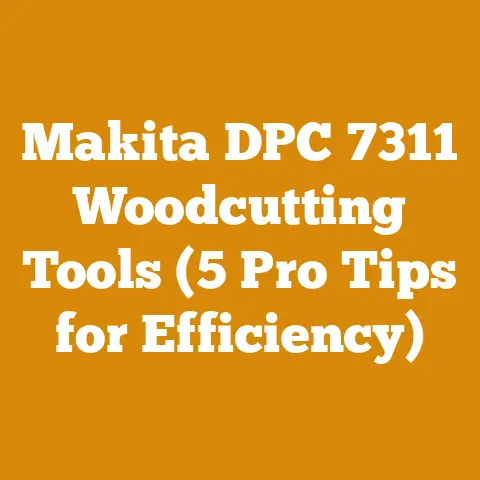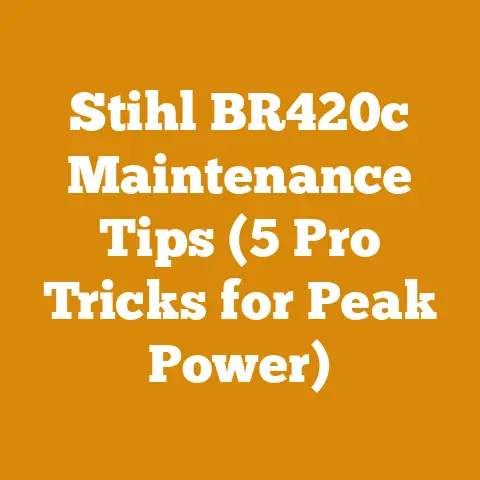Northern Warmth Pellets (5 Pro Tips) for Efficient Wood Heating
Let’s dive into the world of efficient wood heating with Northern Warmth Pellets!
I’ve spent years working with wood, from felling towering trees in the Pacific Northwest to splitting cords of oak under the scorching Texas sun. Through all those experiences, I’ve learned that wood heating isn’t just about throwing logs into a stove; it’s a science, an art, and, frankly, a necessity for many of us. Northern Warmth Pellets offer a fantastic, convenient alternative to traditional firewood, and I’m excited to share my top 5 pro tips to help you maximize their efficiency and warmth.
The Rise of Pellet Heating: A Global Perspective
Before we jump into the tips, let’s take a quick look at why pellet heating is gaining popularity worldwide. The global wood pellet market is booming. According to a recent report by Future Market Insights, it’s projected to reach a staggering $16.01 billion by 2032, growing at a CAGR of 8.5% from 2022 to 2032. This growth is fueled by several factors:
- Environmental Concerns: Pellets are often made from sustainably sourced wood waste, making them a greener alternative to fossil fuels.
- Convenience: Compared to traditional firewood, pellets are easier to store, handle, and load into stoves.
- Efficiency: Pellet stoves offer precise temperature control and burn more cleanly than traditional wood stoves.
However, even with these advantages, getting the most out of your pellets requires a bit of know-how. That’s where my pro tips come in!
Pro Tip #1: Mastering Moisture Control – The Key to Maximum Heat
Think of wood pellets like tiny sponges. If they absorb too much moisture, they won’t burn efficiently, and you’ll end up with a smoky, low-heat fire. Moisture is the nemesis of efficient combustion.
Understanding Moisture Content
Moisture content (MC) is the percentage of a wood pellet’s weight that is water. Ideally, you want your pellets to have a low MC, typically below 8%. Higher moisture content leads to:
- Reduced Heat Output: Energy is wasted evaporating the water instead of heating your home.
- Increased Smoke: Wet pellets produce more smoke, which can be harmful to your health and the environment.
- Creosote Buildup: Smoke contains creosote, a flammable substance that can accumulate in your chimney and pose a fire hazard.
Practical Steps for Moisture Control:
- Inspect the Bags: Before purchasing, check the pellet bags for any signs of damage, such as tears or holes. These can allow moisture to seep in. I once bought a pallet of pellets that had been stored outside, and half the bags were soaked. It was a costly lesson in vigilance!
- Proper Storage is Paramount: Store your pellets in a dry, well-ventilated area. An unheated garage, shed, or even a covered porch can work well. Avoid storing them directly on the ground, as moisture can wick up from the concrete. I recommend using a pallet or placing them on a layer of plastic sheeting.
- Use a Moisture Meter (Optional): For the truly dedicated, a wood moisture meter can provide precise readings. Insert the meter’s probes into a handful of pellets to get an accurate MC measurement. These are readily available online for around $20-$50.
- Recognize Visual Cues: Even without a meter, you can often tell if pellets are damp. Look for discoloration, crumbling, or a musty odor. Healthy pellets should be uniform in color and have a slightly woody smell.
- “The Jar Test”: If you are unsure about the moisture level of your pellets, fill a clear jar about 1/3 full, seal it tightly, and let it sit in a warm room for a day. If condensation forms on the inside of the jar, your pellets are too damp.
Data-Backed Insights:
A study by the Pellet Fuels Institute (PFI) found that pellets with a moisture content of 10% or higher can reduce heating efficiency by as much as 20%. That’s a significant loss of heat and money!
Case Study: A Damp Pellet Disaster
I once helped a friend troubleshoot his pellet stove, which was producing excessive smoke and very little heat. After some investigation, we discovered that he had stored his pellets in a leaky shed. The pellets had absorbed so much moisture that they were practically useless. We ended up having to discard the entire batch and start over with properly stored pellets. It was a frustrating experience, but it underscored the importance of moisture control.
Pro Tip #2: Choosing the Right Pellet – Not All Pellets Are Created Equal
Just like firewood, wood pellets come in different grades and are made from different types of wood. Understanding these differences is crucial for maximizing efficiency and minimizing maintenance.
Understanding Pellet Grades:
The Pellet Fuels Institute (PFI) sets standards for pellet quality, classifying them into three grades:
- Premium: These pellets are typically made from hardwood and have a low ash content (less than 1%). They burn cleanly and produce a lot of heat. I generally recommend using premium pellets for optimal performance.
- Standard: These pellets may contain a mix of hardwood and softwood and have a slightly higher ash content (1-3%). They are generally less expensive than premium pellets but may not burn as cleanly.
- Utility: These pellets are the lowest grade and may contain bark, sawdust, and other waste materials. They have the highest ash content (over 3%) and may produce more smoke and require more frequent stove cleaning. I would advise against using these unless absolutely necessary.
Wood Species and Heat Output:
The type of wood used to make the pellets also affects their heat output. Hardwoods like oak, maple, and hickory generally produce more heat than softwoods like pine and fir. However, softwood pellets often burn hotter and faster, which can be desirable in certain situations.
Ash Content: A Critical Factor
Ash is the non-combustible residue left behind after burning pellets. High ash content can lead to:
- Reduced Efficiency: Ash can insulate the fire, preventing it from burning as hot.
- Increased Maintenance: You’ll need to clean your stove more frequently to remove the ash buildup.
- Potential Stove Damage: Excessive ash can clog the stove’s mechanisms and lead to malfunctions.
How to Choose the Right Pellet:
- Check the PFI Grade: Look for the PFI grade on the pellet bag. This will give you a good indication of the pellet’s quality.
- Consider the Wood Species: If possible, find out what type of wood the pellets are made from. Hardwood pellets are generally a better choice for consistent heat output.
- Read Reviews: Check online reviews to see what other users have to say about different brands and types of pellets.
- Start Small: If you’re trying a new type of pellet, buy a small bag first to see how it performs in your stove.
- Ask Your Stove Manufacturer: Your stove’s manual may recommend specific types of pellets.
Data-Backed Insights:
A study by the U.S. Department of Energy found that using premium-grade pellets can increase heating efficiency by as much as 10% compared to using standard-grade pellets.
Case Study: The Ashy Adventure
I once bought a large quantity of “economy” pellets to save money. Big mistake! They produced so much ash that I had to clean my stove every day, and the heat output was significantly lower than with premium pellets. In the end, I spent more time and effort maintaining my stove, and I didn’t even save that much money. It was a classic example of being penny-wise and pound-foolish.
Pro Tip #3: Stove Maintenance is Non-Negotiable – A Clean Stove is an Efficient Stove
Think of your pellet stove as a well-oiled machine. If you don’t maintain it properly, it won’t run efficiently, and it may even break down. Regular maintenance is essential for optimal performance and longevity.
Key Maintenance Tasks:
- Daily Cleaning: Empty the ash pot daily or as needed. A full ash pot can restrict airflow and reduce heating efficiency.
- Weekly Cleaning: Clean the burn pot and heat exchanger tubes weekly. Use a wire brush to remove any ash or clinkers that have accumulated.
- Monthly Cleaning: Inspect and clean the exhaust vent pipe monthly. A clogged vent pipe can cause smoke to back up into your home.
- Annual Inspection: Have your stove professionally inspected and serviced annually. A qualified technician can identify and fix any potential problems before they become major issues.
The Importance of Proper Ventilation:
Adequate ventilation is crucial for safe and efficient pellet stove operation. Make sure the air intake vents are clear of obstructions, and that the exhaust vent is properly sealed. Poor ventilation can lead to:
- Reduced Efficiency: The stove won’t be able to draw in enough air to burn the pellets efficiently.
- Increased Smoke: Incomplete combustion can produce excessive smoke.
- Carbon Monoxide Poisoning: In extreme cases, poor ventilation can lead to carbon monoxide poisoning.
Tools for Stove Maintenance:
- Ash Vacuum: A specialized vacuum designed for cleaning ash. Regular vacuums can be damaged by the fine ash particles.
- Wire Brush: For cleaning the burn pot and heat exchanger tubes.
- Screwdrivers: For removing and replacing stove components.
- Gasket Material: For sealing the exhaust vent pipe.
- Carbon Monoxide Detector: A must-have for any home with a pellet stove.
Data-Backed Insights:
A study by the Hearth, Patio & Barbecue Association (HPBA) found that regular maintenance can extend the lifespan of a pellet stove by as much as 50%.
Case Study: The Neglected Stove
A neighbor of mine neglected to clean his pellet stove for an entire season. By the end of the winter, the stove was barely producing any heat, and it was constantly emitting smoke. When he finally had it inspected, the technician found that the burn pot was completely clogged with ash, and the exhaust vent was almost entirely blocked. The stove required extensive cleaning and repairs, costing him hundreds of dollars. It was a painful reminder of the importance of regular maintenance.
Pro Tip #4: Fine-Tuning the Feed Rate – Finding the Sweet Spot for Optimal Combustion
The feed rate is the amount of pellets that your stove feeds into the burn pot per unit of time. Adjusting the feed rate can significantly impact your stove’s efficiency and heat output.
Understanding Feed Rate Settings:
Most pellet stoves have adjustable feed rate settings, ranging from low to high. A lower feed rate will produce less heat but will also burn pellets more slowly. A higher feed rate will produce more heat but will also burn pellets more quickly.
Factors Affecting Optimal Feed Rate:
- Pellet Quality: Different types of pellets burn at different rates. You may need to adjust the feed rate depending on the type of pellets you’re using.
- Outdoor Temperature: On colder days, you may need to increase the feed rate to maintain a comfortable temperature.
- Desired Heat Output: Adjust the feed rate to achieve your desired heat output.
How to Adjust the Feed Rate:
- Consult Your Stove Manual: Your stove’s manual will provide specific instructions on how to adjust the feed rate.
- Start Low: Begin with a low feed rate setting and gradually increase it until you achieve your desired heat output.
- Monitor the Flame: Observe the flame in the burn pot. A healthy flame should be bright yellow and dancing. A smoky or sluggish flame indicates that the feed rate is too low. A flame that is too tall and aggressive indicates that the feed rate is too high.
- Adjust Gradually: Make small adjustments to the feed rate and allow the stove to stabilize before making further adjustments.
- Take Notes: Keep track of your feed rate settings and the corresponding heat output. This will help you fine-tune your stove for optimal performance.
Troubleshooting Feed Rate Issues:
- Low Heat Output: If your stove isn’t producing enough heat, try increasing the feed rate.
- Excessive Smoke: If your stove is producing excessive smoke, try decreasing the feed rate.
- Unburned Pellets: If you’re finding unburned pellets in the ash pot, try decreasing the feed rate.
- Clinkers: Clinkers are hard, glassy lumps of ash that can form in the burn pot. If you’re getting a lot of clinkers, try using a higher-quality pellet or adjusting the feed rate.
Data-Backed Insights:
A study by the Biomass Energy Resource Center (BERC) found that optimizing the feed rate can improve heating efficiency by as much as 15%.
Case Study: The Feed Rate Fiasco
I once spent an entire weekend trying to get my pellet stove to burn efficiently. I was constantly adjusting the feed rate, but I couldn’t seem to find the sweet spot. Finally, I realized that the problem wasn’t the feed rate; it was the pellets. I had accidentally bought a batch of low-quality pellets that were burning poorly. Once I switched to a higher-quality pellet, I was able to easily fine-tune the feed rate and get my stove running perfectly.
Pro Tip #5: Smart Thermostat Strategies – Maximizing Comfort and Minimizing Waste
A programmable thermostat is your secret weapon for maximizing comfort and minimizing pellet consumption. It allows you to automatically adjust the temperature based on your schedule and preferences.
Types of Thermostats:
- Basic Programmable Thermostats: These thermostats allow you to set different temperatures for different times of the day.
- Smart Thermostats: These thermostats offer advanced features such as remote control, learning capabilities, and energy usage monitoring.
Benefits of Using a Thermostat:
- Increased Comfort: You can set the thermostat to automatically raise the temperature before you wake up in the morning or return home from work.
- Reduced Energy Consumption: You can set the thermostat to automatically lower the temperature when you’re away from home or asleep.
- Cost Savings: By reducing energy consumption, you can save money on your heating bills.
- Convenience: You can control your stove from anywhere using a smartphone or tablet (with a smart thermostat).
How to Program Your Thermostat:
- Determine Your Schedule: Identify the times of day when you’re typically home and away from home.
- Set Your Desired Temperatures: Set the thermostat to your desired temperature for each time period.
- Use Setback Temperatures: Set the thermostat to a lower temperature when you’re away from home or asleep. A setback temperature of 5-10 degrees Fahrenheit can save you a significant amount of energy.
- Consider Learning Features: If you have a smart thermostat with learning capabilities, let it learn your preferences over time. It will automatically adjust the temperature based on your habits.
- Monitor Your Energy Usage: Use the thermostat’s energy usage monitoring features to track your energy consumption and identify areas where you can save money.
Data-Backed Insights:
The U.S. Department of Energy estimates that using a programmable thermostat can save you as much as 10% on your heating bills.
Case Study: The Thermostat Triumph
I installed a smart thermostat in my home a few years ago, and it has made a huge difference in my energy consumption and comfort level. I can control my stove from my phone, and the thermostat automatically adjusts the temperature based on my schedule and preferences. I’ve noticed a significant reduction in my pellet consumption, and my home is always at the perfect temperature. It was one of the best investments I’ve ever made.
Beyond the Tips: Additional Considerations for Pellet Heating Success
While these 5 pro tips are crucial for maximizing the efficiency of Northern Warmth Pellets, there are a few other factors to consider:
- Stove Placement: Place your stove in a central location in your home to ensure even heat distribution.
- Insulation: Proper insulation is essential for keeping your home warm and reducing energy consumption.
- Air Sealing: Seal any air leaks around windows, doors, and other openings to prevent heat loss.
- Pellet Storage Location: Storing your pellets close to the stove means ease of use and less distance to carry heavy bags.
Troubleshooting Common Pellet Stove Problems
Even with the best planning and maintenance, you might encounter some issues. Here’s a quick troubleshooting guide:
- Stove Won’t Start: Check the power cord, the hopper for blockages, and the igniter.
- Stove Produces Little Heat: Clean the stove thoroughly, check the pellet quality, and adjust the feed rate.
- Excessive Smoke: Ensure proper ventilation, clean the exhaust vent, and try a different type of pellet.
- Stove Shuts Down Unexpectedly: Check for error codes, clean the stove, and ensure proper airflow.
Next Steps: Putting Your Knowledge into Action
Now that you’re armed with my top 5 pro tips, it’s time to put your knowledge into action. Start by inspecting your pellet stove and cleaning it thoroughly. Then, check your pellet storage area to ensure that your pellets are dry and protected from moisture. Finally, experiment with different feed rate settings to find the sweet spot for your stove and your heating needs.
Here are some additional resources to help you on your journey:
- Pellet Fuels Institute (PFI): https://www.pelletheat.org/
- Hearth, Patio & Barbecue Association (HPBA): https://www.hpba.org/
- Local Pellet Stove Dealers: Your local pellet stove dealer can provide expert advice and service.
By following these tips and resources, you can maximize the efficiency of Northern Warmth Pellets and enjoy a warm, comfortable home all winter long. Happy heating!






